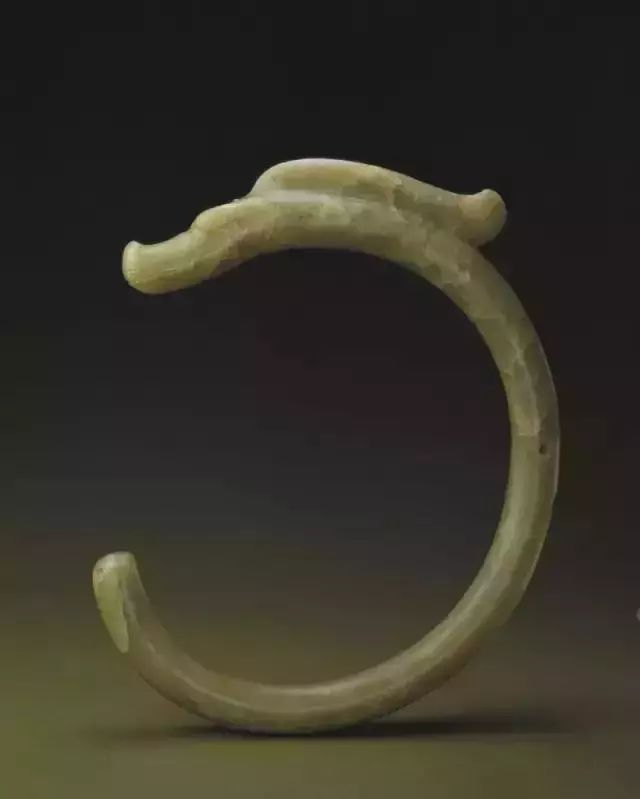Japanese home design is not only famous for its rich history and tradition, but more…
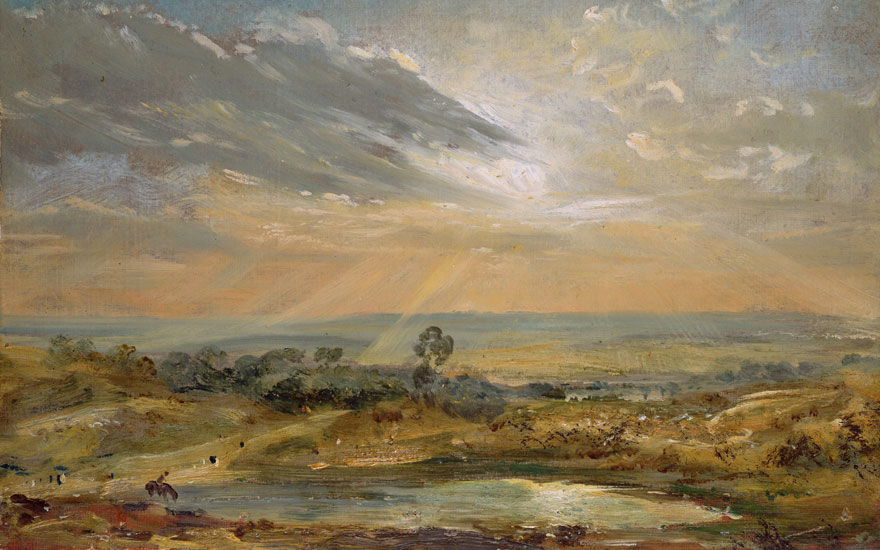
Inspiration from nature: 10 artists who celebrate the natural world
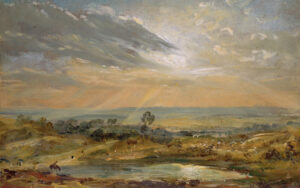
Inspiration from nature: 10 artists who celebrate the natural world
In 1974, the United Nations Conference on the Human Environment adopted a resolution to designate June 5th as “World Environment Day” to encourage residents around the world to raise awareness of environmental protection and take environmental protection actions. To celebrate this important day, Christie’s is looking back at the work of a number of artists who have used nature and the earth as their inspiration and direction. From Switzerland to South America, southern England to the coast of Maine, majestic mountains, oceans, deserts, plains, lakes and forests have touched the hearts of these artists, and hope their work will inspire you too.
Russian pine forest
Siverskaya, 70 kilometers south of St. Petersburg, was a summer resort for urban residents of Russia in the nineteenth century. The famous Russian landscape painter Ivan Shishkin, known as the “Father of the Forest”, created some of his famous works in Siverskaya and nearby forests.
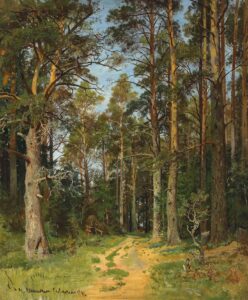
Ivan Shishkin (1832-1898), Siverskaya, 1896. Oil on canvas, mounted on wood. 23¾ x 19¾ in (60.2 x 50.1 cm). Sold for £323,250 on 3 June 2019 at Christie’s in London
Shishkin’s love of nature reflects his patriotic feelings. He was a founding member of the Peredvizhniki (School of Traveling Exhibitions) artists, whose artists depicted people and landscapes in a highly realistic but symbolic way. Shishkin, who saw his country’s magnificent countryside as a symbol of national identity, was also acclaimed for his almost believable paintings of the seasons, animals and birds.
The jagged coast of Shansha Island
New York artist Frederic Church first visited Sandy Island off Maine in 1850 because he had heard it had “the most beautiful” seascape in the country.
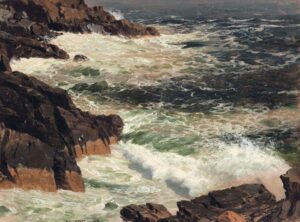
Frederick Church (1826-1900), Raging Waves on Sandy Island, Maine, 1850. Sold for $1,267,500 on 22 November 2016 at Christie’s in New York
Church has never painted a seascape, but he was so attracted by the majestic coastline that he revisited Shansha Island more than ten times in the next 30 years. This early painting is one of Church’s most realistic Maine landscapes, and was inspired by his later visits to South America to depict Maine in a more imaginative tropical style.
English countryside
When John Constable first set foot in the north London suburb of Hampstead in 1819, the village was still part of the outer suburbs of the city. There he produced numerous paintings looking out over the city, as well as depicting what he later referred to as “spectacular clouds, and the effects of light, dark and colour”. For the next seven years, Constable would come to the village every summer to rent a house until 1827 when she officially settled there.
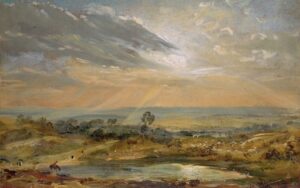
John Constable (1776-1837), Branch Hill Pond, Hampstead, painted 1821-22. Oil on canvas. 24.5 x 39.4 cm. National Victoria and Albert Museum, London. Photo: Bridgeman Images
Constable’s love of nature stemmed from a childhood spent in the Suffolk countryside. He recalled when he grew up: “My childhood was carefree, all because of the beautiful scenery on the banks of the Stauer River. Those scenery made me a painter, and I am very grateful.”
The mountains of Geelong, Australia
Eugène von Guérard was born in Vienna. When he immigrated to Australia in 1852, he was already one of the leading landscape painters in Europe. Fascinated by the “New World” and the gold rush, he traveled to Australia. This work depicts Geelong, Victoria, as a thriving gold mining town at the time, and was made four years after von Glad settled in Australia.
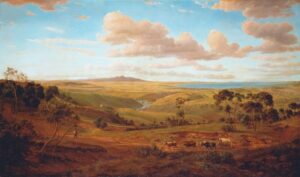
Eugene von Glad, Landscape of Geelong, 1856. Geelong Art Gallery. Purchased in 2006 by the Geelong Art Gallery Foundation with the generous support of the Victorian Government, Australian Government, City of Geelong and various communities and other donors
“Landscape of Geelong” was originally collected by British composer Andrew Lloyd Webber. He sold the work to the Geelong Art Museum through Christie’s private sale service in July 2006.
Von Glad’s meticulous depiction of the Australian landscape has become scientific evidence of a lost world, with conservationists following his painting Tower Hill (now in the Warrnambool Art Gallery) to replant the area due to grazing and mining activities. and disappearing native plants.
Oceano Dunes Nature Reserve, USA
During the 1920s and 1930s, the spectacular coastal dunes and bohemian communities of Oceano, California, attracted the attention of artists, musicians, and photographers. Edward Weston first photographed the dunes in 1934, but his best series of landscapes came in 1936.
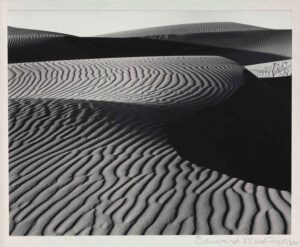
Edward Weston (1886-1958), The Dunes of Oceano, 1936. Sold for $432,500 on 10 October 2017 at Christie’s in New York. Artwork: ©Center for Creative Photography, The University of Arizona Foundation / DACS 2020
For Weston, nature has a direct impact on “the mind and appearance of man”, and he sees landscape photography as a form of activism as documentary photography. Henri Cartier-Bresson accused him and Ansel Adams of social indifference, saying: “The world is about to collapse, but Adams and Weston and others are photographing stone !” Weston responded tartly: “It would be naïve to think that landscape … has no ‘social significance.’ Landscape is far more important to humans in a particular place than the city as a sight to behold.”
rainforests of latin america
Cuban artist Tomás Sánchez’s depictions of tropical ecosystems are “idealized blends of different landscapes”, inspired by his hikes through the forests and mountains of Costa Rica, Cuba, Mexico and Central America. Political tensions forced him to leave Cuba in 1990, but his works still reflect memories of his homeland.
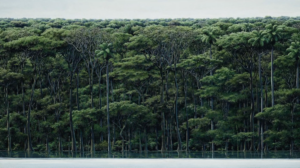
Thomas Sanchez (b. 1948), Coast and Gray Sky, 1995. Acrylic canvas. 23½ x 35½ inches (59.7 x 90.2 cm). Sold for $150,000 on 22 and 23 May 2019 at Christie’s in New York. Artwork: © Tomás Sánchez, Courtesy Marlborough Gallery, New York
In fact, one of Sanchez’s paintings was bought by Raul Castro as a birthday present for his brother Fidel. In an interview with Christie’s Christies.com, Sanchez explained: “I rarely paint directly in nature. It was a place in the Sierra Maestra in Cuba, and it was later discovered that Fidel and his men had been there before the revolution in 1959. Hidden in the Sierra Maestra, he saw this view from his hut.”
new mexico desert
Georgia O’Keeffe writes to artist Arthur O’Keeffe from his home in Ghost Ranch, New Mexico, 1942 Arthur Dove said at the time: “I hope you can see what I see out of the window. The north is earthy pink and yellow cliffs… It’s a very beautiful world.”
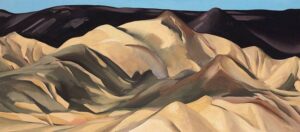
Georgia O’Keeffe (1887-1986), Near Apicho, New Mexico, 1931. Sold for $8,412,500 on 9 May 2018 at Christie’s in New York. Artwork: © Georgia O’Keeffe Museum / DACS 2020
O’Keeffe first came to New Mexico in 1929 and felt immediately gracious. She recalled: “As soon as I saw it, I knew it was my country. I had never seen a landscape like this, but it suited me. The atmosphere here is different.”
After her first visit, O’Keeffe completed Near Abichu two years later, reflecting her love of this vast desert and mountains. O’Keeffe returned to New Mexico almost every year before moving permanently to New Mexico in 1949.
Mount Emei, China
Mount Emei is located in Sichuan Province in southwest China, with a height of 3,099 meters, it is the crown of the four famous Buddhist mountains in China. Mount Emei is a place of pilgrimage, home to dozens of temples, and has been a source of inspiration for artists for thousands of years.
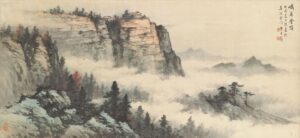
Huang Junbi (1898-1991), “Emei Golden Summit”, made in 1958. Scroll, framed, ink, colored on paper. 56 x 119 cm (22 x 46 ⅞ in). Sold for HK$1,040,000 on 29 May 2012 at Christie’s in Hong Kong
Chinese ink painter Huang Junbi (1898-1991), who lived in Sichuan Province in the 1940s, created this scene of Mount Emei from memory. Together with Zhang Daqian and Pu Ru, he is called the “Three Families Crossing the Sea”, because all three of them left mainland China before 1949, and the Huang family finally settled in Taiwan.
Lake Thun, Switzerland
The Swiss painter Ferdinand Hodler declared that landscape painting should “remove insignificant details and reveal a more magnificent and simpler nature”.
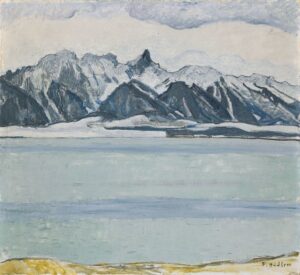
Ferdinand Hodler (1853-1918), Lake Thun and Stockhorn in Winter, 1912-1913. Oil on canvas. 70 x 76.5 cm. Sold for CHF 3,840,000 on 3 December 2007 at Christie’s in Zurich
Hodler produced and admired portraiture, history painting, and symbolism throughout his life, before returning to landscape painting in his later years after decades. The simplicity, symmetry, and repetition of mountain scenes in the landscapes of his later years clearly exemplify the Symbolist style he called “parallelism”. For Hodler, the concept of parallelism is not just an artistic style, but his philosophy that nature and life have their order.
Antarctica
Brazilian photographer Sebastião Salgado began his epic project Genesis in 2004, documenting the world’s most remote uninhabited land. Over eight years he traveled to Antarctica, the Amazon, Siberia and the Galapagos Islands, taking black and white photographs of landscapes, animals and indigenous communities along the way.
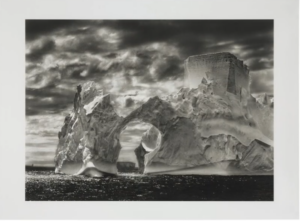
Sebastio Salgado (b. 1944), Iceberg between Paulette Island and South Shetland Islands, Antarctica, 2005. Sold for $32,500 on 6 April 2017 at Christie’s in New York. Art work: © Sebastião Salgado / nbpictures.com
During his trip to the South Pole, Salgado saw the sky “very magnificent and beautiful, shining before you”. Later, he published the book “Genesis” in 2014, which he called “my love letter to the earth”.
He reminded humans: “About 46% of the earth still maintains the appearance of the creation period, and we must protect it.”



